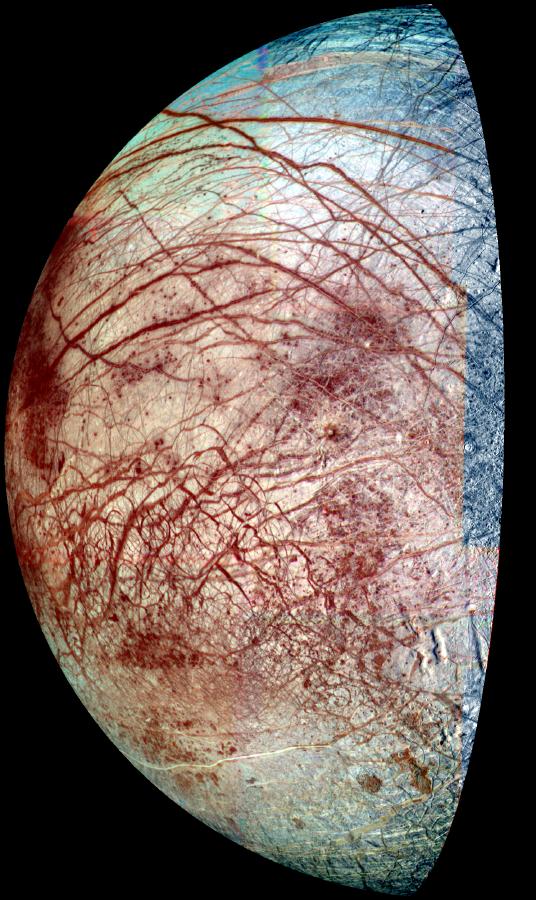NASA JPL | 2010-319 | 04 Oct 2010
Acid Rain-Like Chemistry Could Occur in Europa’s Ice CrustPIA02590: Europa's Frozen Surface
Europa, a moon of Jupiter, appears as a thick crescent in this enhanced-color image from NASA's Galileo spacecraft, which has been orbiting Jupiter since 1995.
The view combines images taken in violet, green and near-infrared filters in 1998 and 1995. The colors have been stretched to show the subtle differences in materials that cover the icy surface of Europa. Reddish linear features are some of the cracks and ridges, thousands of kilometers long, which are caused by the tides raised by the gravitational pull of Jupiter. Mottled, reddish "chaotic terrain" exists where the surface has been disrupted and ice blocks have moved around. The red material at the ridges and chaotic terrain is a non-ice contaminant and could be salts brought up from a possible ocean beneath Europa's frozen surface.
Also visible are a few circular features, which are small impact craters. Europa's surface has very few craters, indicating that recent or current geologic activity has removed the traces of older impacts. The paucity of craters, coupled with other evidence, has led scientists to surmise that there could be an ocean of liquid water beneath Europa's surface. Where there is water, there could be life. This is why Europa is a target of current interest for study of the possibility of non-Earth life. A follow-up spacecraft to Galileo will be Europa Orbiter, which should determine whether or not Europa has an ocean.
Credit: NASA/JPL/University of Arizona The frigid ice of Jupiter's moon Europa may be hiding more than a presumed ocean: it is likely the scene of some unexpectedly fast chemistry between water and sulfur dioxide at extremely cold temperatures. Although these molecules react easily as liquids-they are well-known ingredients of acid rain-Mark Loeffler and Reggie Hudson at NASA's Goddard Space Flight Center in Greenbelt, Md., now report that they react as ices with surprising speed and high yield at temperatures hundreds of degrees below freezing. Because the reaction occurs without the aid of radiation, it could take place throughout Europa's thick coating of ice-an outcome that would revamp current thinking about the chemistry and geology of this moon and perhaps others.
...
From remote observations, astronomers know that sulfur is present in Europa's ice. Sulfur originates in the volcanoes of Jupiter's moon Io, then becomes ionized and is transported to Europa, where it gets embedded in the ice. Additional sulfur might come from the ocean that's thought to lie beneath Europa's surface.
...
In experiments that simulated the conditions on Europa, Loeffler and Hudson sprayed water vapor and sulfur dioxide gas onto quarter-sized mirrors in a high-vacuum chamber. Because the mirrors were kept at about 50 to 100 Kelvin (about minus 370 to minus 280 degrees Fahrenheit), the gases immediately condensed as ice. As the reaction proceeded, the researchers used infrared spectroscopy to watch the decrease in concentrations of water and sulfur dioxide and the increase in concentrations of positive and negative ions generated.
Universe Today | Europa | 04 Oct 2010
Thermally-induced chemistry and the Jovian icy satellites:A new look at how chemicals on Jupiter’s moon Europa may be reacting together could provide new insight to how chemical reactions could be occurring in the moon’s icy crust, despite frigid temperatures. Researchers have found that water and sulfur dioxide react together very quickly, even at temperatures hundreds of degrees below freezing. Because the reaction occurs without the aid of radiation, it could take place throughout Europa’s thick coating of ice. If this is occurring, it would revamp current thinking about the chemistry and geology of this moon and perhaps others.
Europa has temperatures around 86 to 130 Kelvin (minus 300 to minus 225 degrees Fahrenheit), and in those extremely cold conditions, most chemical reactions require an infusion of energy from radiation or light. On Europa, the energy comes from particles from Jupiter’s radiation belts. Because most of those particles penetrate just fractions of an inch into the surface, models of Europa’s chemistry typically stop there.
...
Spectroscopy shows there is sulfur in Europa’s ice, and astronomers believe it originates from the volcanoes of Jupiter’s moon Io, then becomes ionized and is transported to Europa, where it gets embedded in the ice. But originally, astronomers thought not much of a reaction could occur between water ice and the sulfur.
A laboratory study of the formation of sulfur oxyanions - MJ Loeffler, RL Hudson
- Geophysical Research Letters 37 L1920 (02 Oct 2010) DOI: 10.1029/2010GL044553
